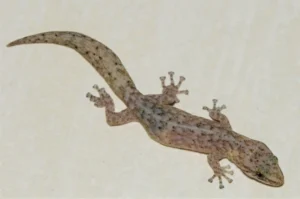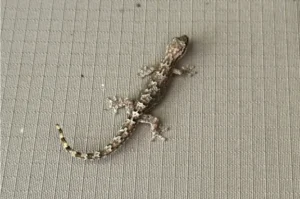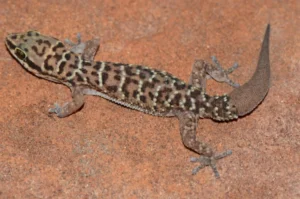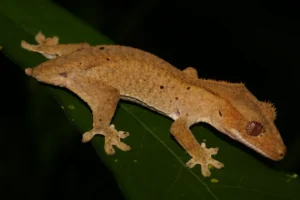You might have seen a gecko running away without its tail, or watched in shock as a gecko’s tail suddenly fell off when you tried to catch it. This strange behavior might seem scary, but it’s actually a clever survival trick. So why do geckos lose their tails?
Geckos lose their tails as a defense mechanism to escape from predators. When a gecko is grabbed by the tail or feels extremely threatened, special muscles break off the tail at a weak point. The dropped tail keeps wiggling to distract the predator while the gecko runs away.
This ability to drop the tail on purpose is called autotomy, and it’s one of the coolest survival tricks in the animal world.
The tail doesn’t just fall off by accident, the gecko controls exactly when it happens.
It’s like having a last-minute escape plan built right into its body.
Geckos Drop Their Tails to Escape Predators
The main reason geckos drop their tails is simple: it keeps them alive. When a predator like a snake, bird, or cat grabs a gecko by the tail, the gecko can get away by leaving the tail behind.

The predator ends up with just the tail while the gecko runs to safety. Without this ability, a lot more geckos would get eaten.
It’s literally a life-or-death choice in a split second.
The break happens in less than a second. Special fracture points in the tail bones make clean breaks possible without hurting the gecko.
These weak spots are like tiny hinges made for survival.
Dropping the tail also lowers long-term risk. Predators often focus on the wiggling tail instead of chasing the gecko, giving it a much better chance to hide, escape, and live to reproduce.
A Gecko’s Dropped Tail Wriggles to Distract Predators
Here’s the amazing part: when a gecko drops its tail, it doesn’t just lie there. It keeps wiggling and thrashing for several minutes.
This movement grabs the predator’s attention, making it focus on the tail instead of the escaping gecko.
The tail’s movement is triggered by nerves that keep firing even after it’s detached, almost like a built-in decoy.
Some tails can wiggle for up to 30 minutes, giving the gecko plenty of time to find a hiding spot.
Some scientists have even seen tails thrash so much that predators completely lose interest in the gecko and go after the tail instead.
How Do Geckos Actually Drop Their Tails?
Geckos have special weak points in their tail bones called fracture planes. These spots are made to break cleanly without causing serious injury.

When a gecko drops its tail, it contracts muscles near the break point. The combination of the predator tugging and these muscles contracting snaps the tail off cleanly.
The break happens between vertebrae, not through them, which makes healing easier and prevents bone problems.
The gecko hardly bleeds, and the wound usually heals quickly without issues.
Not All Geckos Can Drop Their Tails
Most geckos can drop their tails, but not all. Some species have lost the ability over time, often because they live in safer places with fewer predators.
Leopard geckos are famous for dropping their tails easily, while crested geckos can drop theirs but are one of the few species that can’t regrow them.
Species in areas with fewer predators sometimes lose the ability to drop tails. If it’s not needed, evolution doesn’t keep this costly defense. This shows how geckos adapt to different environments.
How Do Geckos Regrow Their Tails After Losing Them?
Most geckos can grow a new tail after losing the old one. This is called regeneration, and it’s pretty amazing.
The new tail starts growing within days. A small bump appears at the break point, and over weeks or months, it grows into a full tail.
How fast it grows depends on the species, age, diet, and health of the gecko.

The new tail isn’t exactly like the old one. It’s usually shorter, has different colors, and feels different because it’s made of cartilage instead of bone. Even so, it still helps with balance and movement, though it doesn’t store fat as well.
A Regrown Gecko Tail Often Looks Different From the Original
You can usually tell if a gecko has regrown its tail. The new tail often looks different from the original.
The color is often duller or doesn’t match the body perfectly. The pattern might be smudged, and the shape is usually stubbier. The texture feels different too. Original tails have the same scales as the body, but regrown tails usually have smaller, smoother scales.
Even so, the new tail still helps the gecko climb, balance, and survive. Over time, geckos adapt to the new tail, even if it’s not as perfect as the first one.
The Hidden Costs of a Gecko Losing Its Tail
Dropping the tail saves the gecko’s life, but it comes at a cost. Growing a new tail takes a lot of energy and nutrients.
During regrowth, the gecko needs more food to fuel the process. This can be risky because it has less balance without a full tail, making hunting or escaping harder.

Geckos also store fat in their tails. Losing the tail means losing those fat reserves, which can be dangerous if food is scarce.
Dropping the tail keeps the gecko alive now but comes with energy and nutrient costs later.
When Do Geckos Drop Their Tails?
Geckos don’t drop their tails casually, it’s a last-resort defense.
Being grabbed by the tail is the most common reason, but extreme stress, rough handling, or attacks from other geckos can also trigger it. Pet geckos sometimes drop tails if they’re handled too roughly or startled.
That’s why you should never pick up a gecko by its tail. Even if it seems small, the gecko might see it as a life-or-death threat.
Stress Can Make Pet Geckos Drop Their Tails by Accident
Sometimes pet geckos drop tails even when there’s no real danger.
Loud noises, sudden movements, aggressive tank mates, or a new environment can stress a gecko enough to trigger tail dropping.
Keeping a calm, predictable habitat reduces stress and prevents unnecessary tail loss, helping your gecko feel safe.
Young Geckos Lose Their Tails More Often Than Adults
Young geckos drop their tails more often than adults. They’re smaller and more vulnerable, and their nervous systems react faster.

As geckos grow, they become better at judging when it’s really necessary to drop the tail, saving energy for other survival needs.
What Else Does a Gecko’s Tail Do Besides Save Its Life?
Tails do more than just save geckos from predators. They’re used for balance when climbing and jumping. Without a tail, geckos are clumsier and more likely to fall.
Tails also store fat and nutrients for times when food is scarce. Losing this storage makes tail dropping a trade-off between surviving now and having energy later.
Some Geckos Can’t Regrow Their Tails
A few gecko species can drop their tails but can’t grow them back. Crested geckos are the most famous example.
When a crested gecko loses its tail, that’s it. A small stub might form, but a full tail never grows back.

This makes tail dropping even more costly, so they only do it if absolutely necessary.
How to Prevent Tail Loss in Pet Geckos
If you have a pet gecko, you can prevent unnecessary tail loss by handling them gently.
Never grab a gecko by its tail. Always support its body and let it walk onto your hands. Keep stress low by providing proper temperature, humidity, hiding spots, and a routine.
Calm, well-cared-for geckos are much less likely to drop their tails.
What to Do If Your Pet Gecko Drops Its Tail
If your pet gecko drops its tail, don’t panic. It’s not an emergency, but you should help.
The wound usually stops bleeding on its own. Keep the habitat clean to prevent infection. Make sure your gecko has plenty of food and water to fuel healing and regrowth.
With good care, most geckos recover quickly and regrow their tails without problems.
Conclusion
Geckos lose their tails because it’s a super effective escape trick. When grabbed by a predator, dropping the wiggling tail distracts the predator while the gecko runs away.
This ability has saved countless gecko lives over millions of years. Even though losing a tail costs energy and takes time to grow back, it’s way better than being eaten.
If you have a pet gecko, understanding why and how they drop tails helps you handle them properly and keep them safe.
A gecko that never drops its tail is a happy, stress-free gecko that feels secure in its environment.
Hi, my name is Ezra Mushala, i have been interested animals all my life. I am the main author and editor here at snakeinformer.com.

